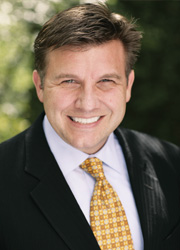
Imagine that you’re an NBA star instead of a stellar MBA. In fact you’re more than a star; you’re one of the top players. Then you make a dramatic career move, accepting a lucrative offer to be a head coach in the league.
Suddenly your job is to lead and motivate others who excel in the very skills you had mastered earlier. Your job no longer involves shooting, passing, rebounding, dribbling and playing defense. Instead you’re responsible for putting the right talent on the floor in the right situations. You have to manage a lineup of inflated egos while keeping everyone focused on working together. You have to map out winning strategies for every game and then communicate them effectively so your players can execute them. You’re also the most public face of the organization, with corresponding responsibilities in handling the media. Few of the skills that took you so far as a player will serve you in this new role. Now you feel all alone.

Michael Burcham, Professor for the Practice of Management, uses the NBA analogy to explain the thinking behind a new program at Owen, Thinking like a CEO, that he helps lead. Like star players turned coaches, CEOs—especially those who are newly promoted into the position or who have grown an entrepreneurial venture into a more substantive, structured enterprise—often struggle in their new roles and make common mistakes that, to outside observers, seem to violate common sense.
The course is the creation of three Vanderbilt professors: Burcham, David Furse, Adjunct Professor of Management, and Kimberly Pace, Clinical Assistant Professor of Management. They recognized a market need for CEO preparation based not on research but on their extensive, hands-on involvement in the world of corporate executives.
Burcham has started and led three health care companies. (He carefully balanced the operation of one, in New Jersey, with his teaching duties at Vanderbilt.) Furse was an entrepreneurial CEO with two decades of experience before joining the ranks of academia. Pace, who directed marketing and communications for two international firms, continues to coach and advise CEOs on managing their “personal brands.” All three professors consult regularly with C-level corporate executives.

Even experienced executives make monumental errors. But basic mistakes, the professors observe, are especially common among CEOs who came into their position through growing a small startup company or through excelling in one area of an established organization. “Some chief executives, for example, came up through a particular area of a company, such as marketing, and have a less-than-thorough understanding of the rest of the organization,” says Furse. “So they may starve the parts of the organization they don’t understand.” Others, who were stars in sales or operations or finance, struggle to learn that “they don’t get to be the star player anymore.” The job, rather, is about empowering everyone else in the company.
“Some CEOs are phenomenal at strategy but not execution,” Pace notes. “Some are good at execution but not strategy. If you’re an elite organization, you have to be great at both. You need the whole package.”

Younger entrepreneurs, in particular, says Furse, set a trap for themselves by trying to be everywhere. Once the organization grows, these startup executives fall prey to their own success. “You can’t directly manage the whole company anymore. You have to develop people and build a management team. A lot of the work we do is helping CEOs develop their senior management teams. No CEO can do it all.”
Burcham recalls one successful technology entrepreneur who was still trying to run his 500-person company the way he did “when it was just him and 15 software programmers.” It didn’t work.
“Few schools teach people to be a CEO,” Burcham observes. “People are promoted into the role. They get there through different skills, and these aren’t necessarily the same skills they will need as a CEO. If you bring a VP’s skills to the position of CEO, you’ll probably make a lot of the same classic mistakes that other CEOs have made.”
This article is an abridged version of the one that appeared in the Spring 2009 edition of OwenIntelligence. To read it in its entirety, click here.

